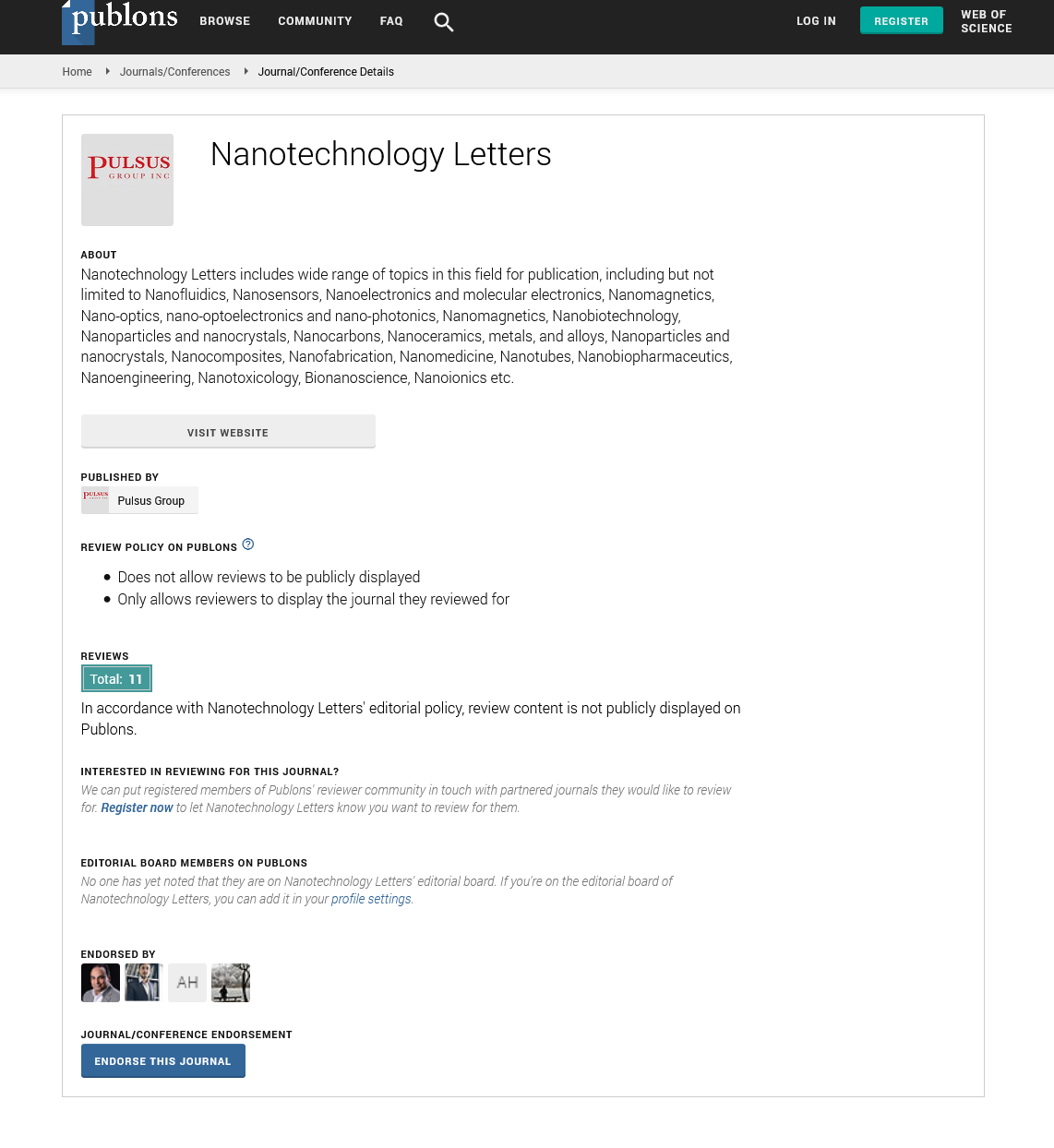Nanocellulose : a brief note
Received: 12-Jan-2023, Manuscript No. PULNL-23-6072; Editor assigned: 19-Jan-2023, Pre QC No. PULNL-23-6072 (PQ); Accepted Date: Jan 27, 2023; Reviewed: 23-Jan-2023 QC No. PULNL-23-6072 (Q); Revised: 27-Jan-2023, Manuscript No. PULNL-23-6072 (R); Published: 28-Jan-2023, DOI: 10.37532. pulnl.23.8 (1) 25-26.
Citation: Shukla T. Nanocellulose : A brief note. Nanotechnol. lett.; 8(1):25-26
This open-access article is distributed under the terms of the Creative Commons Attribution Non-Commercial License (CC BY-NC) (http://creativecommons.org/licenses/by-nc/4.0/), which permits reuse, distribution and reproduction of the article, provided that the original work is properly cited and the reuse is restricted to noncommercial purposes. For commercial reuse, contact reprints@pulsus.com
Abstract
Cellulose, the most prevalent natural polymer derived from plants, wood, and microorganisms, is gaining popularity these days. Researchers have used a variety of ways to extract cellulose from plants, bacteria, algae, and other organisms, including mechanical, chemical, and chemical-mechanical treatments. Cellulose Nanocrystals (CNC), Cellulose Nanofibrils (CNF), and Microcrystalline Cellulose (MCC) have all been extracted and utilised for a variety of purposes, including food packaging, water purification, medicine delivery, and composites
Key Words
Nanocellulose; Biodegradable; Composites; applications
Introduction
Growing environmental concerns, as well as the depletion of fossil resources, have resulted in an ever-increasing need for the creation of sustainable and ecologically acceptable biocomposites. By combining the best qualities of a biodegradable polymer and a natural filler, a biocompatible composite may be created Fiber reinforcement infused with polymers is efficient in improving composite characteristics.
These composites benefit from the use of both polymers and fibres. To improve the mechanical characteristics of composites, an effective load transfer between the polymer and fibre should be achieved. Biofibers have lately gained popularity as reinforcing fillers due to their unique qualities such as low density, cheap cost, biodegradability, ease of availability, recyclability, superior acoustic and thermal insulation, minimal skin irritation, and so on .It is a strategic approach in the advanced composite sector to replace standard carbon and glass fibres with plant fibres. Plant fibres offer several potential applications, including the creation of rural jobs, the improvement of physio-mechanical characteristics, the reduction of energy consumption, and the ability to perform extensive chemistry on the surface of plant fibres. Grinding, high-pressure homogenization, cryocrushing, steam explosion , ultrasonication , enzymatic pre-treatments , and chemical treatments are some of the methods used to isolate nanocellulose from plant fibres. However, mechanical treatments use a lot of energy, hence chemical or chemo-mechanical cellulose treatment techniques are usually favoured .
The chemical formula for cellulose is (C6H10O5)n. Depending on the source, the degree of polymerization (n) ranges between 10,000 and 15,000. It is a homopolysaccharide composed of units of 1, 4 anhydro-D-glucopyranose. Glucose's pyranose structure is made up of six carbon atoms. Acetal linkages (bonds generated by single oxygen) between the C1 carbon of one pyranose unit and the C4 carbon of another pyranose unit connect the glucose units.
Structure of cellulose
The chemical formula for cellulose is (C6H10O5)n. Depending on the source, the degree of polymerization (n) ranges between 10,000 and 15,000. It is a homopolysaccharide composed of units of -1, 4 anhydro-D-glucopyranose . Glucose's pyranose structure is made up of six carbon atoms. Acetal linkages (bonds generated by single oxygen) between the C1 carbon of one pyranose unit and the C4 carbon of another pyranose unit connect the glucose units. Depending on the source, treatments, and techniques of extraction, cellulose exists in four polymorphs: cellulose I, II, III, and IV. The celluloses that have received the greatest attention are cellulose I and cellulose II. Cellulose I, often known as native cellulose, is a naturally occurring crystalline and thermodynamically metastable cellulose. Cellulose I is found in two polymorphs, I α and Iβ. Algae and bacteria consist of Iα, while Iβ is dominated in higher plants.
Sources
Cellulose is the most plentiful natural polymer, derived mostly from woody and non woody wastes, tunicates, bacteria, and algae . Woody and non woody residues are the most abundant cellulose sources. The plant fibre is made up of an external primary cell wall, three secondary walls, and a lumen in the core. The initial cell wall contains cellulose fibres that are haphazardly ordered, whereas the secondary cell wall has cellulose fibres that are helically arranged.Bacterial cellulose is manufactured by bacteria, with Acetobacter xylinum (or Gluconacetobacter xylinus) being the most effective
Classifications
Based on its size, uses, preparation techniques, and source of production, nanocellulose is categorised as Cellulose Nanocrystal (CNC), Nanofibrillated Cellulose (NFC), or Cellulose Nanofibrils (CNF).
Nanofibrillated cellulose
Nanofibrillated cellulose or cellulose nanofibrils are flexible fibres with alternating crystalline and amorphous domains, a high aspect ratio, diameters ranging from 5 nm-30 nm, and lengths ranging from several micrometres NFC may be harvested from a variety of sources, including plants, animals, and microbes. The mechanical treatments and raw natural sources have the greatest influence on the dimensions, crystallinity, and morphology of the resulting fibrillated cellulose. It is often extracted using enzymatic or chemical (pretreatment) techniques, which are then followed by mechanical treatments. The hemicellulose and lignin contents are removed using enzymatic and chemical procedures, while the mechanical approach is utilised to decrease the size of microfibrils to nano dimensions. As a result of pretreatments, cationic and anionic charges are introduced on the surface of the cellulose fibrils.
Cellulose nanocrystal
Cellulose nanocrystals may be produced from a variety of cellulose sources, including plants, animals, microbes, and algae. These are extremely crystalline forms of cellulose that contain 100% cellulose and range in crystallinity from 54% to 88%. It has a high aspect ratio, a high specific strength, a large surface area, and unusual liquid crystalline characteristics. Furthermore, the CNC has a high I crystal structure (68%-94%). They are rod-like whisker-shaped particles with widths ranging from 2 nm to 70 nm and lengths ranging from 100 nm to 600 nm. Typically, cellulose nanocrystals are separated by pre-treating cellulose sources to remove hemicellulose and lignin content, followed by acid hydrolysis or enzymatic treatment of the cellulose fibres . The acid treatment removes amorphous parts of the cellulose fibres and enhances the crystalline concentration.
Applications
Nanocellulose is widely employed in tissue engineering, nanomedicine, biosensors, biodegradable polymers, power storage, water treatment, and other fields due to its outstanding qualities. Vitamin D3 is required for healthy bones and muscles; however, a considerable portion of the worldwide population have insufficient vitamin D3 levels, resulting in weak bones, weak muscles, bone pain, and so on. Colturato et al. employed nanocellulose films in their investigation to solve this difficulty; nanocellulose was used as a medication delivery technology for the regulated release of vitamin D3. Cotton linter and Vitamin D3 were used to make the nanocellulose films. FTIR tests revealed no interaction or creation of new bonds between nanocellulose and vitamin D3. FTIR and SEM analyses also showed the presence of vitamin D3 in the cellulose sample. The rate of vitamin D3 release was determined using UV-vis spectroscopy, which revealed a release of 3029 IU mL of vitamin D3 into the receptor liquid in 1 hour. Nanocellulose is widely employed in medical applications such as medication delivery systems. As a result, the distribution of nanocellulose in cells and tissues must be monitored. Babi et al] effectively fluorescently tagged nanocellulose with a triazine-alkyne linker and azide dyes while preserving the cellulose structure. Using high-resolution fluorescence microscopy, the labelling was optimised and the tagged nanocellulose was detected. Shishehbor and colleagues. Uetani et al. revealed that tunicate nanocellulose sheets had a thermal conductivity of 2.5 W/mK, which is higher than the thermal conductivity of other plastic films used in electronic devices. To reduce overheating, the nanocellulose sheets might be employed as the basis material for flexible electrical devices. Using Balsa wood, Fu et al. created cellulose-based flexible electronics (Ochroma pyramidale). Balsa wood was chemically treated to eliminate hemicellulose and lignin before being pressed with large loads to produce a flexible transparent wood film with high strength and modulus.
Applications of cellulose fiber reinforced polymer composites
Cellulosic fiber-reinforced polymer composites have been used in a variety of industries including autos, aeroplanes, packaging, medical implants, electronics, and construction materials, among others. This section discusses some of the most important research on the application of cellulosic fiberreinforced composites. Soni, Asoh, and Uyama created water-insoluble starch/cellulose nanofiber composites in an intriguing study. The films were made by casting TEMPO-oxidized cellulose nanofiber into three distinct modified starches (hydroxypropyl starch, acetyl starch, and acetyl oxidised starch). The TEMPO-oxidized cellulose nanofiber/hydroxypropyl starch (HPS) composite had the maximum tensile modulus and tensile strength, as well as good transparency. Because of the large number of OH groups in hydroxypropyl starch, the excellent performance of the TEMPO-oxidized cellulose nanofiber/Hydroxypropyl Starch (HPS) composite was attributable to the creation of hemiacetal bonds between the component polymers. The produced films can be used instead of single-use plastics.






